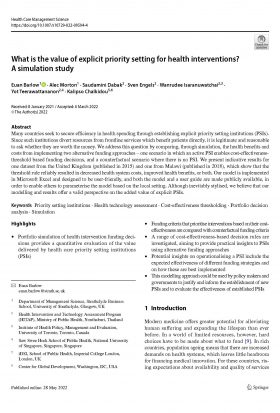This website uses cookies so that we can provide you with the best user experience possible. Cookie information is stored in your browser and performs functions such as recognising you when you return to our website and helping our team to understand which sections of the website you find most interesting and useful.
What is the value of explicit priority setting for health interventions? A simulation study

รายละเอียดเพิ่มเติม
Abstract
Many countries seek to secure efficiency in health spending through establishing explicit priority setting institutions (PSIs). Since such institutions divert resources from frontline services which benefit patients directly, it is legitimate and reasonable to ask whether they are worth the money. We address this question by comparing, through simulation, the health benefits and costs from implementing two alternative funding approaches – one scenario in which an active PSI enables cost-effectiveness-threshold based funding decisions, and a counterfactual scenario where there is no PSI. We present indicative results for one dataset from the United Kingdom (published in 2015) and one from Malawi (published in 2018), which show that the threshold rule reliably resulted in decreased health system costs, improved health benefits, or both. Our model is implemented in Microsoft Excel and designed to be user-friendly, and both the model and a user guide are made publicly available, in order to enable others to parameterise the model based on the local setting. Although inevitably stylised, we believe that our modelling and results offer a valid perspective on the added value of explicit PSIs.




